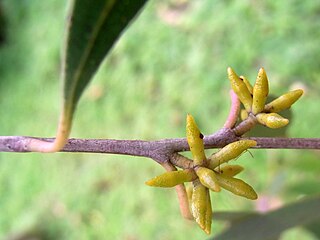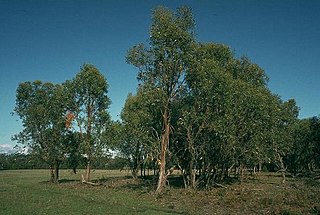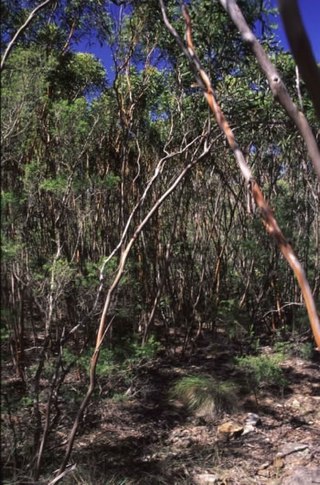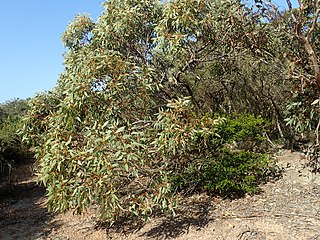
Eucalyptus pulverulenta, commonly known as silver-leaved mountain gum, is a species of straggly tree or mallee that is endemic to southern New South Wales. It has smooth bark, egg-shaped, heart-shaped or round, sessile leaves arranged in opposite pairs, flower buds in groups of three, white flowers and cup-shaped to cylindrical fruit.
Eucalyptus recurva, commonly known as Mongarlowe mallee, is a species of dense mallee shrub that is endemic to a small area of New South Wales. It has smooth bark, a crown consisting of unusually small, juvenile leaves, flower buds in groups of three, white flowers and hemispherical fruit. It is only known from six extremely old multi-stemmed individual plants and is classed as "critically endangered".

Eucalyptus copulans is a species of small, critically endangered tree only known in the wild from one or two individual plants in the Blue Mountains of New South Wales. It has smooth bark, usually with several main stems, lance-shaped adult leaves, flower buds in group of eleven or more and more or less spherical fruit.

Eucalyptus kitsoniana, commonly known as the Gippsland mallee or bog gum, is a species of small tree or mallee and is endemic to Victoria. It has mostly smooth bark, a crown containing juvenile, intermediate and adult leaves, flower buds in groups of seven, white flowers and sessile, cup-shaped to hemispherical fruit.

Eucalyptus parvula, commonly known as small-leaved gum, is a species of small tree that is endemic to south-eastern New South Wales. It has mostly smooth bark, elliptical to lance-shaped adult leaves but with many juvenile of intermediate leaves in the crown, flower buds in groups of seven, white flowers and cup-shaped fruit.

Eucalyptus langleyi, commonly known as the green mallee ash or albatross mallee, is a species of mallee that is endemic to a small area of New South Wales. It has mostly smooth grey to yellowish bark, lance-shaped to curved adult leaves, flower buds in groups of seven, white flowers and cup-shaped to barrel-shaped fruit.

Eucalyptus subcrenulata, commonly known as Tasmanian alpine yellow gum, is a species of small to medium-sized tree that is endemic to the highlands of Tasmania. It has smooth bark, glossy green, lance-shaped to egg-shaped adult leaves, flower buds in groups of three, white flowers and hemispherical to bell-shaped fruit. It is similar to E. johnstonii, E. vernicosa and E. urnigera.

Eucalyptus castrensis, commonly known as Singleton mallee or Pokolbin mallee box, is a species of mallee that is endemic to a small area of New South Wales in eastern Australia. It has mostly smooth bark, lance-shaped adult leaves, flower buds in groups of seven, white flowers and cup-shaped fruit.

Eucalyptus canobolensis, commonly known as the Mount Canobolas candlebark or silver-leaf candlebark, is a species of tree that is endemic to a small area of New South Wales in eastern Australia. It is a small tree with smooth bark on the trunk and branches, dull, lance-shaped adult leaves, flowers buds in groups of three, white flowers and cup-shaped, bell-shaped or conical fruit. It is only known from Mount Canobolas near Orange.
Eucalyptus vicina, commonly known as the Manara Hills red gum, is a species of mallee in the family Myrtaceae and is endemic to western New South Wales. It has smooth bark, lance-shaped to curved adult leaves, flower buds in groups of seven, white flowers and cup-shaped or hemispherical fruit.

Eucalyptus boliviana, commonly known as Bolivia Hill stringybark or Bolivia stringybark is a shrub or a mallee, sometimes a small tree and is endemic to a small area in northern New South Wales. It is a stringybark with four-sides stems, broadly lance-shaped adult leaves, flower buds arranged in groups of seven, yellow flowers and hemispherical to broadly funnel-shaped fruit.

Eucalyptus magnificata, commonly known as blue box or northern blue box, is a species of small tree or sometimes a mallee that is restricted to a small area of New South Wales. It has rough, fibrous or flaky bark on the trunk and larger branches, smooth bark above, broadly lance-shaped to egg-shaped leaves, flower buds in groups of seven, white or pale yellow flowers and conical fruit.
Eucalyptus quinniorum, commonly known as monkey gum, is a species of mallee or a small to medium-sized tree that is endemic to northern New South Wales. It has smooth bark with persistent, stringy bark near the base, linear to narrow lance-shaped adult leaves, flower buds in groups of seven, white flowers and hemispherical to cylindrical fruit.

Eucalyptus balladoniensis, commonly known as the Balladonia mallee, is a mallee that is endemic to an area in the south of Western Australia. It has rough bark on the lower half of its stems, smooth brownish bark above, lance-shaped leaves, flower buds in groups of seven, pale yellow flowers and hemispherical to more or less spherical fruit.

Eucalyptus burdettiana, commonly known as Burdett gum or Burdett's mallee, is a species of flowering plant in the family Myrtaceae and is endemic to Western Australia. It is a mallee or shrub with smooth bark, lance-shaped adult leaves, flower buds with an elongated horn-shaped operculum, greenish-yellow flowers and cup-shaped or bell-shaped fruit.

Eucalyptus kessellii, commonly known as Jerdacuttup mallee, is a species of mallee that is endemic to an area along the south coast of Western Australia. It has very hard, rough bark on the trunk of larger specimens, smooth greyish and brownish bark above, lance-shaped to egg-shaped adult leaves, flower buds in groups of three or seven, creamy white flowers and downturned, conical to cup-shaped fruit.
Eucalyptus luculenta is a species of mallee that is endemic to a small area on the south coast of Western Australia. It has smooth bark, lance-shaped to egg-shaped leaves, flower buds in groups of seven, pale yellow to white flowers and cup-shaped, barrel-shaped or cylindrical fruit.
Eucalyptus peninsularis, commonly known as Cummins mallee, is a species of mallee that is endemic to a small area of South Australia. It has smooth, greyish or brownish bark, lance-shaped adult leaves, flower buds in groups of between seven and eleven, pale creamy yellow flowers and urn-shaped fruit.
Eucalyptus kabiana, commonly known as Mt Beerwah mallee, is a species of mallee, rarely a small tree, that is endemic to Queensland. It has smooth white to grey bark, sometimes with a short stocking of rough, fibrous bark at the base. The adult leaves are lance-shaped or curved, the flower buds are arranged in groups of between seven and eleven, the flowers are white and the fruit is hemispherical with protruding valves.

Eucalyptus notactites, commonly known as southern limestone mallee, is a species of mallee that is endemic to the southwest of Western Australia. It has smooth, greyish bark, lance-shaped adult leaves, flower buds in groups of between eleven and fifteen, creamy white flowers and hemispherical fruit.





















